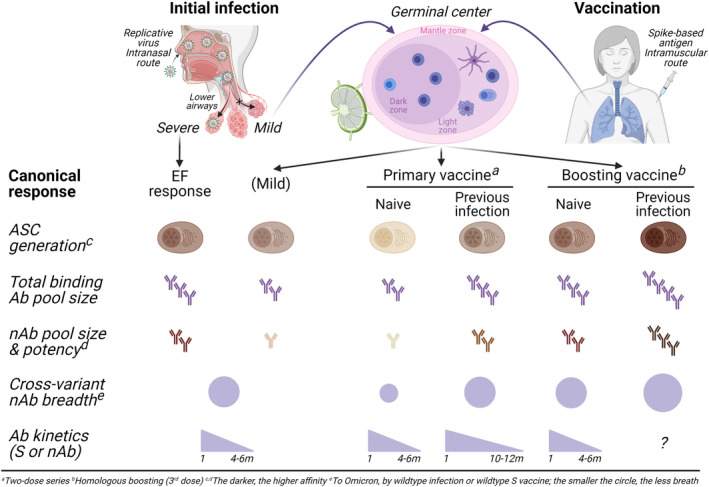FIGURE 2.

ASC kinetics and Ab effector functions during responses to infection with and vaccination against SARS‐CoV‐2. Initial infection induces ASC that produce virus‐specific, low‐affinity serum Abs. In general, mild infection, priming vaccination, or tertiary vaccination generates a GC response, by which the derived MBC undergo continued clonal evolution over 6‐12 mo, leading to the production of more potent and broader nAbs. The frequency of ASC generally correlates with the magnitude of the serum Ab levels (total binding Ab pool size). Dose 1 vaccine induces a robust GC response resulting in the generation of virus‐specific ASC (and MBC) including in infection‐naive subjects and which is substantially enhanced either by Dose 2 (in infection‐naive subjects) or in previously infected (recovered) subjects—and further enhanced by boosters (in infection‐naive subjects). The highest total binding Ab production is observed in recovered, tertiary vaccinees. Dose 1 ignites potent nAbs (in about half the subjects) that are enhanced by Dose 2 and further enhanced by booters—against the wildtype but less potent against variants (decreasing cross‐variant nAb potency). S‐specific and nAbs wane over 4‐6 mo following infection, although total binding Abs could be detected 18‐20 mo post‐infection. The nAb waning period of time in COVID‐19‐naive vaccinees also are usually 4‐6 mo; it may last longer in previously infected subjects (i.e., 10‐12 mo). Ab, antibody; nAb, neutralizing antibody; ASC, antibody‐secreting cell; EF, extrafollicular; S, spike
